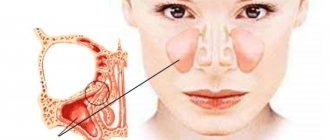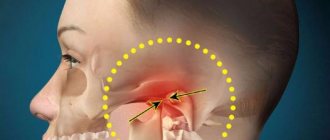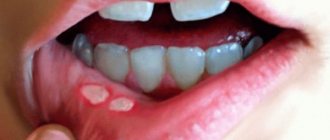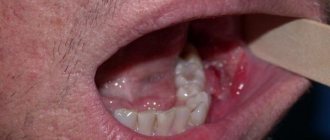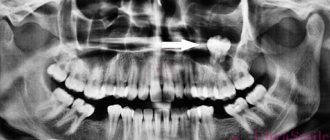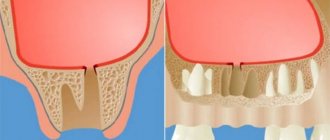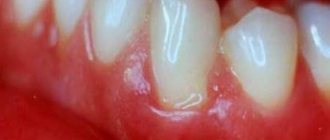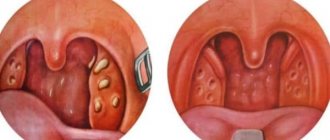Symptoms and signs of the disease
The general symptoms of sphenoiditis are very vague, so the disease is difficult to diagnose correctly. Patients often suffer from this disease for decades without adequate treatment. These common symptoms include:
- Headache;
- Asthenovegetative manifestations;
- Impaired vision and smell;
- Pathological discharge from the sphenoid sinus;
- Damage to the cranial nerves.
Headache is one of the first symptoms of sphenoiditis. Due to the accumulation of air and fluid in the sphenoid sinus, pressure on tissue and bone structures equipped with sensitive nerve receptors increases. The receptors are also affected by toxins released during cell breakdown as a result of prolonged inflammation. In most cases, the headache is aching in nature, without precise localization. Patients describe it as pain inside, in the center of the head. With the gradual filling of the sphenoid sinus with purulent discharge, the pain is localized in the parietal region and gradually moves to the occipital region. Sometimes the pain radiates to the temple, deep into the orbit, and less often to the base of the skull.
With sphenoiditis, especially chronic, asthenovegetative disorders come to the fore. The sphenoid sinus closely borders the meninges, pituitary gland, hypothalamus, and base of the skull. A long-term inflammatory process, the development of infection and massive destruction of cells in the mucous layer lead to the accumulation of large amounts of toxins that penetrate the nervous tissue of the base of the brain, causing various neurological symptoms, such as:
- Sleep disturbance;
- Decreased appetite;
- Skin sensitivity disorder;
- Memory impairment;
- Dizziness;
- Persistent low-grade fever (within 37.1 – 37.9 degrees);
- Hyperemia of the skin of the face;
- General weakness and malaise;
- Irritability.
One of the main symptoms of sphenoiditis is pathological discharge from the sphenoid sinus. With a strong inflammatory process, pathological fluid begins to accumulate in the sphenoid sinus. Initially, abundant mucous discharge appears. When an infection occurs, the discharge becomes purulent. They accumulate in the sinus cavity until they find a way out of it. Usually, due to increased internal pressure, pus begins to flow down the back of the throat. The secretion is difficult to cough up. The patient feels discomfort and irritation in the depths of the nose and throat, and often tries to cough. Sometimes an unpleasant smell of purulent secretion appears.
Often patients suffering from sphenoiditis consult a doctor with complaints of impaired vision and smell. This is explained by the fact that the sphenoid sinus is anatomically located on the border with the olfactory part of the nose and the optic nerves.
When the inflammatory and infectious process spreads to the nasal mucosa, the olfactory receptors of the nose are affected, and then the patient ceases to perceive odors correctly. In advanced cases, anosmia occurs - loss of smell.
The inflammatory and infectious process can also spread to the fibers of the optic nerves. Due to prolonged edema, ischemia (decreased blood supply) of the nervous tissue occurs, as a result of which optic neuritis can develop, which manifests itself in various visual disturbances. Visual acuity decreases, black dots appear in the field of vision.
If the inflammatory and infectious process penetrates the cavernous sinus and covers the nerve fibers, then trigeminal neuritis will develop, which is manifested by impaired sensitivity of the facial skin.
Treatment without puncture
In addition to drainage (puncture), treatment can be carried out in other ways. This includes laser therapy and physical procedures.
The “cuckoo” procedure without a puncture is considered to be the most effective. When medicine is pumped under pressure through the nose into the nasal sinuses and washed, getting rid of mucus and pus. This procedure helps in a non-running state. Along with it, a course of antibiotics is also needed.
After the first procedure, the patient feels relief. The course is designed for 5 procedures on average. Treatment without a puncture is less painful, so many people try it first.
Do not forget that throughout the entire treatment it is necessary to use vasoconstrictor nasal drops and spray, also combining them with home rinsing the nose with salt water or saline.
Rehabilitation after physical procedures and punctures is not required, you just need to be more attentive to any cold and its symptoms, take care of your health and get treatment on time.
One of the most modern ways to prevent inflammation of the maxillary sinuses and other diseases of the upper and lower respiratory tract can be considered a visit to salt rooms, enriched with a huge content of salts in the air. Salt rooms are suitable for adults and children over one year old.
Inflammation of the maxillary sinuses (sinusitis) - what is this disease?
Sinusitis is an inflammation of the maxillary sinuses, accompanied by the secretion of mucus and pus, making breathing difficult.
The maxillary sinuses are located in the nasal cavity, they are also called maxillary or maxillary. For a better understanding, you need to imagine a container, a bottle with a volume of 10 ml filled with air, where the base is the outer wall of the nasal cavity, and the upper part is the zygomatic process of the jaw.
What is sinusitis
This will be the maxillary sinus, which, through a small hole located at the base of the orbit, connects to the middle nasal passage. It is not the closedness of the space that becomes the main reason for the development of inflammatory processes, given the thinness of the lower wall of the maxillary sinus.
Attention! Since the maxillary cavities border both the orbit and the dental arch, if they are damaged, meningitis, eye and dental diseases can occur.
So, sinusitis is an inflammatory disease of the maxillary sinuses, accompanied by the release of mucopurulent secretion from the nasal passages, difficulty breathing, increased body temperature, headaches, and photophobia. On an x-ray, the liquid (pathological secretion) is visible, like milk in a glass with a clearly visible level.
How to recognize left-sided or right-sided sinusitis?
In medicine, sinusitis has two names. Another one appears as maxillary sinusitis. In turn, pathology is divided into several types:
- Catarrhal. In this case, the purulent mass has a bright green tint with mucus impurities;
- Purulent. The contents are accompanied by an unpleasant odor. When blowing your nose, the presence of yellow dense lumps is observed;
- Allergic. The presence of allergic reactions negatively affects the condition of a person’s skin and respiratory tract. Allergic sinusitis is an excessive accumulation of mucus in the sinuses. It has a uniform structure and transparent color;
- Viral. A similar pathology occurs after suffering from viral and colds. Usually a runny nose goes away on the fifth day, sinusitis with viral microflora lasts from 15 to 30 days from the moment of infection. A course of antibiotic therapy and physical therapy helps prevent further spread into the meningeal cavity;
- Parietal. The disease is located in the upper parts of the paranasal sinuses;
- Polypous. This pathology occurs as a result of a long-term allergic reaction. The consistency of the discharge is presented in the form of transparent mucus. In this case, nasal breathing is difficult. Patients prefer to breathe through their mouth. As a result, their appetite and taste perception of food decreases;
- Left-handed. The main cause of unilateral sinusitis is a crooked nasal septum. This leads to the appearance of pathological changes in the area of anastomosis. A person experiences changes in aeration. As a result, the mucous membrane is constantly subject to inflammation and irritation;
- Right-handed. This type develops using the same technology as their left-sided sinusitis;
- Bilateral. In this case, inflammatory foci are present on both sides of the maxillary sinuses. The contents have a dense structure of a green-yellow hue.
Rare complications of the disease
Rare complications include subperiosteal abscess of the eyeballs, which develops in the wall of the eye orbit. The most acute symptoms are observed if the disease occurs after frontal sinusitis, manifesting itself:
- high temperature;
- swelling, soreness of the skin of the forehead and eyelid;
- swelling of the conjunctiva of the affected eye;
- decreased visual acuity, double vision.
If a subperiosteal abscess forms as a complication of ethmoiditis, then the manifestations of the disease are less pronounced. Symptoms of complications are:
- eye soreness;
- redness of the conjunctiva;
- inflammation of the lacrimal sac.
An abscess that appears after sinusitis of the maxillary cavity is often accompanied by lacrimation, pain, and redness of the lower eyelid. If the sphenoid sinuses are involved in the inflammatory process, then the subperiosteal abscess is complicated by neuritis or optic nerve atrophy, blindness, meningitis, and encephalitis.
Purulent inflammation of the sinuses can lead to periostitis of the orbit. The disease is accompanied by:
- heat;
- weakness;
- acute pain that intensifies when pressing on the eyeball;
- impairment of free movement of the eye in the orbit.
If antibiotics are not used in a timely manner, the manifestations of the purulent form of the disease intensify and lead to blindness, sepsis, brain abscess, and meningitis.
Inflammation of the paranasal sinuses - complications
Due to anatomical conditions, the proximity of the sinuses to the orbit and cranial cavity sometimes leads to serious complications, which can be divided into:
1. Ocular and orbital complications:
- orbital abscess - most often occurs in the superomedial region of the orbit and moves the eyeball in the opposite direction. If left untreated, it leads to orbital phlegmon,
- orbital phlegmon is a very serious complication, which can even result in blindness. It is characterized by exophthalmos and immobilization of the eyeball, as well as lack of pupillary response to light.
- blepharitis - can take a purulent form (a consequence of an orbital abscess) or a non-purulent form, which is congestive swelling of the subcutaneous tissue,
- Optic neuritis - can be a complication of inflammation of the sphenoid sinus, posterior ethmoid cells, as well as a consequence of orbital phlegmon.
About
Main symptoms
Inflammation of the sinuses can be suspected when observing the following symptoms:
- nasal discharge (they usually have an extremely unpleasant odor), thick consistency and containing pus;
- sharp pain if a person tilts his head;
- temperature increase;
- malaise;
- runny nose;
- red eyes;
- cough.
Moreover, inflammatory processes in the sinuses have different courses:
- Acute – with pronounced symptoms;
- Chronic – the duration lasts longer than a month (often begins because the acute form is not cured in a timely manner and is neglected).
ENT will help treat inflammation of the sinuses.
The right step in this case is to contact a qualified otolaryngologist who:
- diagnoses the disease;
- will determine all its possible forms;
- will prescribe appropriate treatment.
You can only assume the presence of an illness, based on the observed symptoms, and provide yourself with first aid so as not to prolong the illness.
What other symptoms are there?
Among the symptoms of sinus inflammation, it is worth noting not only a feeling of heaviness in the head and breathing problems, but also:
- abdominal bloating;
- flatulence;
- weakening of the entire body.
Almost every time the patient gets up from a lying position, he experiences severe dizziness.
Swelling of the mucous membrane leads to a constant runny nose. The throat feels very dry (which leads to the development of cough syndrome). It seems as if the tongue is coated.
The mood can be panicky: a feeling of fear often arises. There is a tingling sensation in my arms and legs.
The face (as well as the lower limbs) swells and turns pale. The neck as well as the shoulders may be a little sore.
Most often, the temperature rises to low-grade levels, although it is possible that it can rise to 39 degrees (in such cases, you can take antipyretics).
One of the symptoms of inflammation is fever
If you lightly tap on the outside of your sinuses, it will hurt.
In the photo of discharge from a runny nose caused by an inflammatory process, their greenish color is noticeable.
Discharge due to inflammation of the sinuses
By the way, to combat a runny nose in the situation described, you cannot use vasoconstrictor drops! They only disrupt the motility of the mucous membrane and impair blood supply.
Symptoms of sinusitis (according to forms of disease)
Spicy
Acute sinusitis how to determine? Symptoms of acute sinusitis in adults are as follows:
- a runny nose that lasts more than 7-10 days, with no improvement observed;
- difficulty breathing through the nose;
- mucus flows down the back wall, purulent sputum comes out in the morning;
- painful sensations in the head, dental pain syndrome;
- hypersensitivity of the facial skin in the area of the inflamed sinus;
- fever;
- weakness, lethargy, fatigue, irritability;
- photophobia, lacrimation, poor appetite, sleep disturbance;
- impaired sense of smell;
- swelling of the cheeks, eyelids.
Chronic
Chronic inflammation of the paranasal sinuses is accompanied by weak and scant symptoms. The patient is visited by the following signs:
- runny nose;
- scant mucus discharge from the nose, drying crusts may be present;
- constant leakage from the nose, due to which cracks and abrasions form;
- dry throat;
- painful sensations in the head;
- halitosis.
If chronic sinusitis worsens, then it is characterized by acute symptoms.
Subacute
The subacute course of the pathology is characterized by mild symptoms. It lasts up to 2 months. The patient has been experiencing mild symptoms of sinusitis for a long time, which he mistakes for a classic cold.
Exudative
This type of sinus inflammation differs from all others in that the symptoms of sinusitis are almost invisible. The only thing that worries the patient is the copious discharge of exudate (liquid discharge from the nose). Because of this, full nasal breathing is impaired. Exudative sinusitis is divided into purulent and catarrhal.
Catarrhal
The release of both liquid and viscous exudate is characteristic. The causes of sinusitis are the presence of extensive swelling of the nasal mucosa and soft tissue injury. The catarrhal form is distinguished by the absence of purulent discharge. For sinus inflammation, the symptoms are:
- with sinusitis, the headache is aching in nature and can affect one side (for example, if there is left-sided sinusitis, then the pain can be traced to the left);
- poor appetite and sleep;
- rise in body temperature;
- burning and dryness in the nose;
- sudden loss of the ability to perceive smells;
- redness of the mucous membrane;
- increased secretion of tear fluid;
- general poisoning of the body.
Hyperplastic
The disease hyperplastic sinusitis is accompanied by thickening of the nasal mucosa. Because of this, normal breathing is disrupted. Hyperplastic sinusitis forms against the background of a prolonged inflammatory process. Even during remission, the sinus opening does not expand.
Polyposis
This sinusitis in adults is characterized by the growth of polyps in the nasal cavity. Because of this, a serious obstacle arises to the normal outflow of sinus contents and the flow of air.
Viral
Viral sinusitis is the result of ARVI. This fact complicates the diagnosis of damage to the paranasal sinuses at an early stage of development. The viral form of pathology is different in that you can get rid of it in a short time using only antiviral therapy.
Bacterial
Bacterial sinusitis is a complication of a common runny nose. It occurs against the background of bacterial damage. When the sinuses become inflamed, they make themselves felt after 7 days. Bacterial sinusitis is accompanied by the following symptoms:
- general malaise;
- severe cough with fever and purulent discharge;
- headache.
Odontogenic
Odontogenic sinusitis affects the maxillary sinus. Develops against the background of pathologies of teeth and gums. Odontogenic sinusitis is accompanied by the following symptoms:
- headache;
- nasal discharge;
- difficulty breathing through the nose;
- swelling of the soft tissues of the cheek.
Vasomotor
This type of pathology can be allergic and neurovegetative. It is characterized by general weakness, increased fatigue and decreased ability to work. The patient complains of headaches, poor sleep and appetite.
Vasomotor sinusitis can be recognized by symptoms such as:
- loss of the ability to perceive smells;
- dry nose;
- runny nose.
Cystic
With this form of pathology, cystic formations form in the nasal cavity. Cystic sinusitis is accompanied by the following symptoms:
- runny nose;
- feeling of fullness;
- headache;
- symptoms of sinusitis (heaviness in the head, pain in the temples, fever, loss of smell).
Treatment methods for sinusitis
Sinusitis is a serious disease that requires an integrated approach to treatment.
Self-medicating sinusitis is dangerous - the disease can become chronic. Advanced sinusitis is fraught with complications from internal organs. To avoid this, you need to consult an otolaryngologist (ENT). It is advisable to do this immediately after the first symptoms of sinusitis appear.
If you are looking for where to go for sinusitis in Moscow, contact Family Doctor JSC. The Family Doctor clinics provide treatment for sinusitis in both adults and children.
Nasal rinsing
First of all, treatment of sinusitis involves removing pus from the paranasal sinuses. For this purpose, nasal rinsing is carried out according to Proetz (using the “cuckoo” method). Washing is carried out using special equipment (ENT combine).
Removal of pus with YAMIK sinus catheter
Removal of pus from the sinuses can be performed using the YAMIK sinus catheter, which operates by creating controlled pressure in the nasal cavity and paranasal sinuses.
Sinus piercing
In cases where other methods are ineffective, pus is removed using puncture (puncture of the sinus).
Antibacterial therapy
To suppress the activity of the bacterial infection and prevent complications, the doctor may prescribe antibiotics.
Make an appointment Do not self-medicate. Contact our specialists who will correctly diagnose and prescribe treatment.
Rate how useful the material was
thank you for rating
Frontitis: drugs for treatment. Scroll
Since bacteria are almost always the causative agents of the disease, its treatment is carried out mainly with antibiotics.
Ideally, nasal discharge is initially examined and it is found out which microorganism caused the inflammatory process, as well as how sensitive it is to various antibiotics.
Until the results of this analysis are received, the patient is prescribed amoxicillin in combination with clavulanic acid. There are a number of drugs on the market containing these substances, these are:
- Augmentin SR;
- Amoklavin;
- Flemoklav Solutab;
- Amoxiclav and others
Subsequently, this penicillin antibiotic is replaced by another, to which the causative agents of the disease have shown greater sensitivity. Although, if frontal sinusitis occurs without the presence of discharge, it is fought with the medications presented above. In addition to penicillins, cephalosporins and macrolides can be used, in particular:
- Cefaclor;
- Summed;
- Cefuroxime;
- Azithromycin;
- Ceftriaxone;
- Macropen;
- Cefotaxime, etc.
If acute frontal sinusitis is just beginning, you can try to cope with it with local antibiotics, for example:
- Isophroy;
- Polydexa;
- Bioparox;
- Levomicol.
In addition, the following are often prescribed:
Decongestants.
These drugs are classified as vasoconstrictors and are necessary to eliminate swelling. Initially, patients are recommended to use mild agents, for example, ephedrine solution or phenylephrine in combination with dimethindene.
In the future, the use of drugs oxymetazoline (Nazivin, Noxprey, Nazol, etc.), naphazoline (Naphthyzin, Sanorin, etc.), xylometazoline (Galazolin, Xylobene, Dlynos, etc.) may be recommended.
Decongestants. Prescribing Furosemide or intravenous administration of a 1% CaCl solution to patients is necessary in the absence of any discharge.
Antihistamines. Zyrtec, Ebastine, Loratadine and others are also necessary to eliminate swelling of the mucous membrane, which significantly complicates breathing.
Homeopathy. Lymphomyosot, the popular Sinuforte, Echinacea compositum are used for exacerbation of chronic sinusitis and the acute form of the disease.
Antipyretic. Paracetamol and ibuprofen are used for fever above 38.5°C and severe, persistent headaches.
Erespal is often prescribed to patients, and rinsing of the nasal cavity is also indicated. In case of frontal sinusitis, it is recommended to carry out this procedure in a clinic.
Its essence is to administer, using a conventional blood transfusion system, 100–200 ml of saline solution heated to body temperature with lactoglobulin or an antibiotic, to which the pathogens have been found to be hypersensitive.
The patient is seated, his head is tilted so that the auricle touches the shoulder. The tip of the system is inserted into the nasal passage, which is on top, and the solution is poured in at a speed of about 40 drops/min. An indicator of the correctness of the procedure is pouring the solution from the opposite nostril.
Diagnostics
The specialist first examines the patient, identifying symptoms and collecting the necessary data. Previous therapy used in the treatment of the disease and the duration of the pathology similarly play a large role in the diagnosis. The doctor may need to palpate the sinuses and perform a rhinoscopy.
Diagnosis of pathology can be carried out through fluoroscopic examination. Thanks to x-rays, you can detect or obtain confirmation of the manifestation of the inflammatory process in the sinuses, and identify neoplasms in the nasal cavity. Computed tomography will provide the necessary information about the stage of the disease and its course.
You should visit a doctor in the following cases:
- Correct therapy does not produce results: the symptoms cannot be eliminated.
- The patient was previously susceptible to sinusitis (possibly more than once) and was unable to fully recover.
- Symptoms last for one week or more.
Timely diagnosis will help minimize risks and avoid complications. ENT diseases often become chronic due to their initiation by the patient.
Causes of sinusitis
Most often, sinusitis is a complication of acute inflammation in the nasal cavity. Such inflammation can be caused by any infection - viral (ARVI, influenza), bacterial, fungal. Any acute respiratory disease (ARI), expressed in a common runny nose, can lead to sinusitis. When you have a runny nose, the amount of secretion produced by the glands of the mucous membrane of the nasal cavity sharply increases, as a result of which the mucous membrane swells, blocking the outlet openings of the sinuses.
Factors contributing to the transition of inflammation to the mucous membrane of the paranasal sinuses are:
- curvature of the nasal septum and structural features of the nasal passages that prevent the natural cleansing of the paranasal sinuses;
- long-term inflammation in the nasal cavity. This is typical for chronic runny nose (allergic or vasomotor rhinitis);
- blowing your nose. When you blow your nose, purulent secretions from the nasal cavity enter the sinuses, causing inflammation there.
Infection in the paranasal sinuses can also come from other foci of inflammation, for example, from the tonsils (in the case of chronic tonsillitis). In the case of inflammatory diseases of the teeth of the upper jaw (pulpitis, periodontitis), the infection can penetrate into the sinus from the area of the tooth root. Sinusitis of this origin is called odontogenic
.
The development of sinusitis is promoted by general and local hypothermia. Decreased immunity is also a factor favoring the disease. Problems with the immune system, resulting in a tendency to allergic reactions, increase the likelihood of sinusitis.
Procedures
The method of rinsing the nose in a hospital setting is called “Cuckoo”. This unusual name is due to the fact that during the procedure the patient is asked to repeat the words “cuckoo”. This is necessary to ensure that the liquid does not enter the nasopharynx.
To carry out the procedure, a vacuum suction with a reservoir is used. The liquid entering through the syringe flushes out accumulated mucus, particles of dust and dirt, and blood clots from the nasal passages.
Many patients, especially children, do not like the procedure. Cuckoo is contraindicated for patients suffering from epilepsy, mental disorders, and bleeding disorders.
It is not given to children under 5 years of age. Cuckoo is not effective for severe forms of sinus inflammation.
Another method of cleansing the paranasal sinuses is the Yamic catheter. It is also used for mild forms of inflammation. After removing the contents, the medicine is administered.
These may be antibacterial or mucolytic agents. To consolidate success, this procedure must be completed 5-6 times.
The use of the Yamik catheter is prohibited in cases of deviated nasal septum, frequent nosebleeds, epilepsy, and in old age. The procedure is not contraindicated for children, but the child will need psychological preparation before undergoing it.
More details about the methods:
Symptoms
Bilateral sinusitis occurs with pronounced symptoms, especially in children.
Patients complain of high body temperature - up to 39 ºС, general weakness, nasal congestion, copious discharge of mucus from the nose, and headaches.
Bilateral purulent sinusitis in acute form is even more severe: mucus stagnates in the sinuses, and a bacterial infection develops in the body. This provokes high body temperature, fever, general weakness, malaise, severe headaches, a feeling of heaviness in the head and pain in the face.
Symptoms include headache, watery eyes, nasal congestion, redness and itching, cough
Chronic bilateral sinusitis in adults has a less pronounced clinical picture, but there are more symptoms:
- Headache;
- A bursting or squeezing feeling behind the eye sockets and in the cheek area;
- Nasal congestion and scanty discharge during remission;
- General weakness, fatigue associated with chronic cerebral hypoxia and intoxication;
- Regular dry cough caused by mucus running down the walls of the throat;
- Nasal voice;
- Swelling of the cheeks and eyelids;
- Conjunctivitis and photophobia;
- Impaired sense of smell.
Symptoms
There is no general clinical picture; the nature of the manifestation of the pathological process will depend on what exactly caused the manifestation of such a symptom.
Redness of the nose
Redness of the wings of the nose and the skin around them, which will resemble a mask in shape, may be a manifestation of an autoimmune disease, which will be characterized by approximately the following clinical picture:
- red, plaque-shaped rashes, often with scaly edges;
- the formation of painful lesions on the oral mucosa and in the nose area;
- chest pain that will only get worse when you try to take a deep breath;
- frequent headaches, dizziness;
- disturbances in the functioning of the central nervous system;
- exacerbation of existing chronic diseases;
- sudden mood swings, frequent attacks of irritability and aggression;
- disorders of the genitourinary system - frequent and painful urge to urinate, menstrual irregularities, decreased libido;
- muscle weakness;
- general malaise.
Due to the fact that this is a systemic autoimmune disease, symptoms can manifest themselves in the functioning of any body system.
Irritation and redness of the nose and the skin around it can be a manifestation of dermatological diseases. In this case, the following clinical picture occurs:
- severe peeling of the affected areas of the skin;
- the formation of scales that are easily removed;
- hair loss in the affected areas of the skin;
- the appearance of acne.
In some cases, pimples may form at the site of redness, which later develop into small blistering formations with liquid or purulent exudate in the middle. The localization of rashes can be not only relative to the face, but also to the back, chest, arms to the elbow. There should be no rashes in the genital area.
For diseases that relate to other body systems and are not fungal in nature, this symptom may be accompanied by the following:
- high blood pressure;
- headaches, dizziness, which may be due to nasal congestion;
- pain in the nasal septum, which can spread to the eyes and frontal area of the head - with chronic rhinitis, sinusitis;
- disruption of the functioning of the gastrointestinal tract, which will be expressed in nausea and vomiting, unstable stools, abdominal pain, loss of appetite;
- enlargement of the submandibular, cervical, inguinal lymph nodes;
- lack of sexual desire, discomfort during sexual intercourse;
- general deterioration of health;
- a sharp decrease or, conversely, increase in body weight.
In this case, based on the clinical picture alone, it is impossible to establish the etiology of why the nose became red and swollen. To do this, you should seek medical help. The doctor will carry out all the necessary diagnostic procedures and make the correct diagnosis, based on which it will be clear how to get rid of such a symptom.
Inflammation of the maxillary sinus
Inflammation of the maxillary sinus (sinusitis) is a complex and dangerous disease. The symptoms of sinusitis can be very easily confused with toothache and headache, so only a doctor can diagnose the disease.
There are two stages of the disease. When inflammation is acute, only the tissues and blood vessel system are affected. In the chronic stage, the disease already affects the bone of the maxillary sinus. The inflammatory process develops very quickly if left untreated or neglected, and the inflammation can be either unilateral or bilateral.
Basically, inflammation of the maxillary maxillary sinus is a complication after rhinitis, the father-in-law of a common runny nose. Sinusitis can affect both a child from 3 years of age and an adult. It occurs especially often during the cold season.
There are several causes of sinusitis:
- Reduced immunity after illness or as a complication after sinusitis or rhinitis. Moreover, pregnant women and nursing mothers can be included in this category, since it is they who have reduced immunity due to pregnancy.
- Deviation of the nasal septum and, as a result, difficulty breathing. Inflammation of the adenoids in children can also be attributed to the cause of breathing problems.
- Staphylococcus.
- Neglect in the treatment of acute respiratory viral infections and acute respiratory infections, runny nose (rhinitis, sinusitis).
- Sick teeth can cause sinusitis (pulpitis or caries).
- Allergy.
- Chronic tonsillitis and pharyngitis.
- Bacteria. Since sinusitis can be bacterial and is treated with a separate group of antimicrobial drugs, a sample is taken from the nasal cavity to identify the pathogen. This type of sinusitis most often occurs in children.
It is dangerous to engage in self-diagnosis and under no circumstances should you start treatment, so at the first incomprehensible pain in the face you should seek help from a doctor, because if treatment is not started in time, sinusitis can lead to serious complications.
As already mentioned, only a doctor can diagnose inflammation of the maxillary sinuses. But there are symptoms by which the patient can determine for himself whether it is worth seeing a doctor.
- Headache in the frontal lobe or above the eyebrows, worsening when tilting the head down.
- Pain in the temporal lobe, when the form of the disease is already advanced, pain occurs throughout the face, a constant feeling of heaviness.
- Temperature (not the main symptom).
- Breathing problems, especially in the evening and at night. Nasal congestion and swelling can be either temporary or permanent, blocking both sides of the sinuses or alternately.
- Runny nose, discharge can be colorless or purulent.
- The nose, bridge of the nose and cheek may swell.
- If inflammation is a consequence of acute respiratory viral infections and acute respiratory infections, then the symptoms of such diseases may also appear later with sinusitis.
Causes of infection
With inflammation of the main sinus, it is believed that the process is provoked in most cases by viruses, but bacterial and fungal infections are possible.
Disease factors:
- viruses;
- bacteria;
- fungus;
- allergens;
- environmental irritants;
- deviated nasal septum;
- immunodeficiency.
In adults, after a viral infection of the upper respiratory tract, a secondary bacterial infection of the paranasal sinuses can be caused. Bacterial pathogens include a variety of streptococci. In addition, facultative anaerobic microflora has a beneficial effect on inflammatory processes and contributes to the development of chronic inflammation. Most often, inflammation of the maxillary sinus is detected; this is considered the most common disease in the competence of otolaryngology.
Features of the disease
Older children with inflammation of the nasal sinuses complain of mucopurulent discharge from the nose, congestion, difficulty breathing, and a feeling of fullness in the eye area. In acute cases of the disease, an increase in temperature is also noted. In children, inflammation is characterized by a longer course. Manifested by difficulty breathing, bad breath, cough, congestion in the nasal passages.
In infants, the disease is accompanied by general symptoms, such as moodiness, lack of appetite, weight loss, tearfulness, and poor sleep. Swelling of the eyelids is also often observed. This is due to the fact that in babies the ethmoid sinus is located near the eye sockets, and the wall between them is not yet sufficiently formed.
Treatment is selected separately for each child, depending on his age, form of the disease and severity. It often involves taking antibiotics for 2-3 weeks, as well as medications that act to narrow the sinus mucosa. Antihistamines, antipyretics, painkillers, and moisturizers are also required.
If conservative treatment does not provide any improvement and bone destruction begins, surgery may be required. The danger of acute inflammation is that if there is no treatment, complications may arise. Therefore, with this diagnosis, the child is often hospitalized.
When the first symptoms of sinus inflammation appear, treatment should be started immediately to prevent the rapid spread of the pathological process and the occurrence of complications. Systemic therapy includes taking medications such as:
- antibiotics;
- anti-inflammatory;
- antihistamines;
- mucolytics.
The road to sinusitis begins with untreated or neglected rhinitis. The disease can be triggered by infection (bacteria and viruses) and allergies. Many people are familiar with the symptoms of sinusitis:
- nasal congestion plus nasal voice;
- purulent discharge that is green or yellow in color, although it may not be present with nasal congestion;
- headache at the base of the nose, especially with sudden movements;
- impaired sense of smell;
- swelling of the face;
- general weakness;
- in some types - increased temperature.
All this is a consequence of the fact that in the sinuses, which in a healthy state are connected to each other by small channels, some cavity is blocked, the air in it penetrates into the blood and it begins to fill with inflammatory fluid. Here the activity of pathogenic bacteria is activated. Moreover, the disease can develop only in one sinus, or maybe in both.
Inflammation of the paranasal sinuses - types
The disease most often develops in the maxillary sinus and ethmoid bone cells, less often in the frontal sinuses and less often in the sphenoid sinus. Inflammation usually affects several sinuses at once, which occurs due to the close proximity of the nasal cavity.
In practice, the following can be distinguished:
- acute sinusitis
- acute recurrent
- chronic.
Acute inflammation is caused by viruses and usually lasts up to 10 days. Very rarely (up to 2% of cases) it turns into bacterial inflammation. Acute inflammation of bacterial etiology resolves within 2 weeks in more than half of the cases. Acute recurrent inflammation is diagnosed with 4-6 relapses per year, and standard treatment leads to cure . In turn, we talk about chronic inflammation when symptoms last more than 8-12 weeks and the changes do not improve despite proper treatment. Research shows that more than 50% of patients with asthma suffer from sinusitis, so it can be considered an important risk factor for this disease.
Clinical signs and diagnostic features
Individual symptoms depending on the cause of the disease have already been given above. There are also more general symptoms that indicate sinusitis. They are also taken into account during diagnosis and can be noticed by the patient himself. This includes:
- runny nose;
- blocked nasal passages;
- pain in the facial part, the location of which is associated with a specific area (frontal sinuses, maxillary, etc.);
- increased body temperature;
- attacks of coughing and sneezing;
- copious discharge of a thick consistency;
- bad odor from the mouth;
- nasal voice.
Separately, it is worth noting the symptoms in children with inflammation of the ethmoid sinuses. This may include displacement of the visual organs and swelling of the eyelids. Such signs are due to the fact that in young children the nasal cavity and visual system are not fully formed. If the defect is not noticed in time, the baby’s vision may be impaired.
It is noteworthy that the disease is especially difficult for infants to diagnose. The fact is that you can always ask kids who can talk about their well-being. But babies require constant monitoring. If the child looks unwell, it is better to call a doctor.
The most accurate diagnosis is carried out using computed tomography. This method is the most informative compared to conventional x-rays. Using a camera, the doctor can find out how much pus has accumulated in the paranasal sinuses, whether there is mucosal hypertrophy, and much more. Laboratory studies of the secreted secretions are also carried out. This is necessary to accurately identify the causative agent of inflammation.
Treatment
To relieve the inflammatory process in the paranasal sinuses and significantly improve the patient’s condition, various methods are used, the choice of which is based on the severity of the disease and the individual characteristics of the body.
Surgical
Puncture
This method of treatment involves puncture of the maxillary sinuses. But given the frequent occurrence of complications after this procedure, today doctors use a more modern method of treatment - the use of the Yamik device, which allows fluid to be removed from the sinuses without a puncture. The procedure is performed under anesthesia and the patient does not feel any painful symptoms.
Treatment recommendations
If the disease is accompanied by such unpleasant sensations, be sure to consult a doctor. Severe pain usually indicates that sinusitis is in an advanced state, therefore, without surgical and professional intervention, this can lead to serious complications.
To eliminate pain, it is recommended to start complex treatment on time and not deviate from the doctor’s instructions. Very often, even after a visit to a specialist and the appointment of competent therapy, a person relaxes at home. Medicines often lead to relief in 1-3 days, although the course is designed for 5-10 days. By stopping taking medications, you thereby provoke not just a relapse of sinusitis, but also complications due to it.
As you already understand, pain is directly related to the accumulation of mucus and pus in the sinuses. Therefore, the first priority is to get rid of mucus and ensure effective drainage. There are several methods you can use to do this. But keep in mind that if you have a deformed bridge of the nose, be sure to discuss the choice of method for rinsing your nose with your doctor.
- Washing. They can help a lot if you start treatment in the initial stages of sinusitis. There are both home and clinical methods, which will require visiting a medical facility. The simplest and most classic method of washing in a hospital setting is cuckoo. At home, you can rinse your sinuses with saline solution, sea salt solution, or special pharmaceutical mixtures;
- Mucolytics. Common pharmaceutical drugs that can quickly remove accumulated mucus. How to relieve pain? Take a mucolytic drug prescribed by your doctor. These are agents with a diluting principle of action, stimulating the release of mucous masses from the nose;
- Preparations with vasoconstrictor and anti-inflammatory principles of action. We recommend buying a spray, since it penetrates better into the nasal sinuses than nasal drops. There are a number of highly effective remedies that will relieve inflammation and pain with literally one press of the spray. But such drugs should not be abused. They only help remove mucus, but if used frequently, they become addictive and can dry out the nasal mucosa.
Pain Remedies
Sometimes a person is very bothered by the pain of sinusitis. Therefore, rinsing or spraying alone cannot solve the problem.
Doctors allow taking painkillers. They serve as a temporary remedy to relieve pain. For example, by taking it, it will be easier for you to perform a nasal rinsing procedure or wait for anti-sinusitis medications to take effect.
The following are usually used to relieve pain from sinusitis:
- Analgin;
- Ketanov;
- Aspirin;
- Paracetamol;
- Ketolong, etc.
Please note that for mild to moderate pain you should not take strong medications. Analgin tablet is enough. For sinusitis and the pain that accompanies it, you should resort to medications such as Ketanov in the most extreme cases.
Complications and consequences of untreated sinusitis
Sinusitis is a very complex disease, and if properly treated, patients can face serious consequences:
- the appearance of swelling of the maxillary sinuses;
- inflammation of the mucous membrane;
- violation of nasal breathing;
- strong discharge of mucus from the nose;
- accumulation of pus in the maxillary cavities, etc.
After treatment of sinusitis, some patients experience various complications:
- very often the acute form of sinusitis passes into the chronic stage, which requires longer constructive treatment;
- inflammatory processes of the bronchopulmonary system, pharyngeal tonsils and other organs develop;
- against the background of the inflammatory process, otitis media appears.
Patients who have been diagnosed with an advanced stage of sinusitis may encounter more serious complications in which various diseases appear:
- kidney;
- hearts;
- joints;
- organs of vision;
- brain, etc.
When complications go beyond the boundaries of the bronchopulmonary system and damage to other internal organs, patients may encounter sepsis. If the patient, upon identifying the primary symptoms of sinusitis, immediately goes to a medical facility and undergoes medication and physiotherapeutic treatment, he will be able to avoid any consequences and complications of this disease.
Features of treatment for adults and children
Inflammation of the maxillary sinuses in adults and children is treated for 3-14 days, depending on the stage of the disease. The means used are:
Antibacterial drugs that suppress the activity of pathogenic bacteria (Amoxicillin).
Amoxicillin
Analgesics that help relieve pain (Apetaminophen, Ibuprofen, Aspirin).
Mucolytic agents to reduce nasal discharge (Guaphenesin).
Guafenesin
Corticosteroids that relieve inflammation (Beclamethasone dipropionate, Prednisolone).
Medicines used to relieve swelling of the mucous membrane (Pseudoephedrine hydrochloride).
Pseudoephedrine hydrochloride
Inhaled antibiotics acting directly on the mucous membrane (Fluimucil).
Fluimucil
Video about the treatment of sinusitis in a child:
